Blue Helix |
|||||||||||||||||||||||||||||||||||||
 |
 |
||||||||||||||||||||||||||||||||||||
Circle crocheted jacket in 1 strand DROPS Nord + 1 strand DROPS Kid-Silk. Piece is worked with lace pattern. Size: S – XXXL
DROPS 194-36 |
|||||||||||||||||||||||||||||||||||||
|
EXPLANATION FOR THE PATTERN: ---------------------------------------------------------- PATTERN: See diagrams A.1 to A.3. CROCHET INFO-1: Replace first single crochet at beginning of round with 1 chain stitch, finish round with 1 slip stitch in 1st chain stitch at beginning of round. Replace first double crochet at beginning of round with 3 chain stitches, finish round with 1 slip stitch in 3rd chain stitch at beginning of round. Replace first treble crochet at beginning of round with 4 chain stitches, finish round with 1 slip stitch in 4th chain stitch at beginning of round. CROCHET INFO-2 (transition to next round): Work slip stitches to first stitch on next round. If there is a chain space on last round work chain stitches until middle of first chain space on round. NOTE: Applies from the end of 3rd round in A.1 and until finished measurements. INCREASE TIP: Increase 1 chain space as follows: Work * 1 single crochet + 1 chain space *, work from *-* 2 times in total around same chain space. DECREASE TIP (applies to sleeves): NOTE: Pattern displaces the beginning of round, therefore adjust so that the 2 decreases are done mid under sleeve. Decrease 1 chain space as follows: Work 1 single crochet around chain space, 1 single crochet around next chain space, 6 chain stitches. ---------------------------------------------------------- START THE PIECE HERE: ---------------------------------------------------------- JACKET - SHORT OVERVIEW OF THE PIECE: Work piece in the round in a circle from mid back of back and outwards. Work armholes on the circle. Work front pieces back and forth and then work a finishing edge around the entire circle. Work sleeves in the round, top down. CIRCLE: Work 4 chain stitches on hook size 5 mm = US H/8 with 1 strand Nord + 1 strand Kid-Silk (= 2 strands) and form a ring with 1 slip stitch in first chain stitch made. Then work pattern in the round according to diagram A.1 7 times in total on round - read CROCHET INFO-1 and CROCHET INFO-2. REMEMBER THE CROCHET GAUGE! When A.1 has been worked vertically, there are 49 chain spaces on last round. The circle measures approx. 34 cm = 13⅜" in diameter. Cut the yarn, and begin next round in 4th chain space = mid back/neck. Now continue in the different sizes as follows: SIZE S-M: = 49 chain spaces. Work first round in A.2 - AT THE SAME TIME work armholes as follows: Work around each of the first 7 chain spaces, work 35 loose chain stitches (= armhole), skip 8 chain spaces, work around each of the next 19 chain spaces, work 35 loose chain stitches (= armhole), skip 8 chain spaces, work around each of the last 7 chain spaces. Repeat 2nd round in A.2 - AT THE SAME TIME increase - read INCREASE TIP, as follows: Work around each of the first 7 chain spaces - increase 2 chain spaces over these chain spaces, work 10 chain spaces/single crochets around armhole (= 2 increases), work around each of the next 19 chain spaces - increase 7 chain spaces over these chain spaces, work 10 chain spaces/single crochets around armhole (= 2 increases), work around each of the last 7 chain spaces - increase 2 chain spaces over these chain spaces (= 15 increases in total on round) = 64 chain spaces. Then work 3rd round in A.2 without increasing. The circle measures approx. 45 cm = 17¾" in diameter. SIZE L/XL - XXL/XXXL: = 49 chain spaces. Work first round in A.2 - AT THE SAME TIME increase 15 chain spaces evenly (i.e. increase 1 chain space over approx. every 3rd chain space) - read INCREASE TIP = 64 chain spaces. Work second round in A.2 - AT THE SAME TIME work armholes as follows: Work around each of the first 8 chain spaces, work 38-41 loose chain stitches (= armhole), skip 9 chain spaces, work around each of the next 30 chain spaces, work 38-41 loose chain stitches (= armhole), skip 9 chain spaces, work around each of the last 8 chain spaces. Then work 3rd round in A.2 without increasing. The circle measures approx. 45 cm = 17¾" in diameter. ALL SIZES: = 64 chain spaces for all sizes Then work diagram A.3 in the round, work A.3 5-6-7 times in total vertically - AT THE SAME TIME increase on round marked with arrow in diagram - remember INCREASE TIP, as follows: Increase 16 chain spaces on every round with increase, i.e. 1ST TIME: Increase 1 chain space around every 4th chain space = 80 chain spaces. 2ND TIME: Increase 1 chain space around every 5th chain space = 96 chain spaces. 3RD TIME: Increase 1 chain space around every 6th chain space = 112 chain spaces. 4TH TIME: Increase 1 chain space around every 7th chain space = 128 chain spaces. 5TH TIME: Increase 1 chain space around every 8th chain space = 144 chain spaces. Now continue in the different sizes as follows: SIZE S-M: Fasten off. The circle measures approx. 100 cm = 39⅜" in diameter. SIZE L/XL: 6TH TIME: Increase 1 chain space around every 9th chain space = 160 chain spaces. Fasten off. The circle measures approx. 111 cm = 43¾" in diameter. SIZE XXL/XXXL 6TH TIME: Increase 1 chain space around every 9th chain space = 160 chain spaces. 7TH TIME: Increase 1 chain space around every 10th chain space = 176 chain spaces. Fasten off. The circle measures approx. 122 cm = 48" in diameter. ALL SIZES: = 144-160-176 chain spaces. Continue working only over 40-44-47 chain spaces in each side – i.e. do not work over 32-36-40 chain spaces at the top by neck and 32-36-42 chain spaces at bottom of back. Continue with explanation under left front piece. LEFT FRONT PIECE: = 40-44-47 chain spaces. Continue back and forth as follows: ROW 1: Work slip stitches until middle of the first chain space, 1 single crochet, * work 6 chain stitches, 1 single crochet around next chain space *, repeat from *-* and finish with 1 single crochet around last chain space = 39-43-46 chain spaces. Repeat 1st row 3-3-7 more times. There are 36-40-39 chain spaces at the edge of front piece. Cut the yarn. RIGHT FRONT PIECE: Work same way as on left front piece over 40-44-47 chain spaces in the right side. Fasten off. FINISHING EDGE: Work an edge around the entire circle as follows: Work last round in A.3, i.e. over every chain space work 1 single crochet and 3 chain stitches. Then work 1st round in A.3, i.e. work 3 treble crochet around every chain space. Fasten off. Piece measures approx. 104-115-126 cm = 41"-45¼"-49½" in diameter vertically and approx. 114-126-146 cm = 45"-49½"-57⅜" in diameter in width. SLEEVE: Work sleeve in the round from armhole. Begin mid under sleeve and work 57-63-66 treble crochets evenly around armhole (= approx. 3 treble crochets around every chain space) = 1st round in A.3. Continue in the round on A.3 to and with last round. Then repeat A.3 vertically - AT THE SAME TIME decrease 2 chain spaces mid under sleeve, decrease on round marked with arrow in diagram - read DECREASE TIP. Decrease like this on every round marked with arrow 4-5-5 times in total = 11-11-12 chain spaces. Continue without decrease until sleeve measures approx. 42-44-46 cm = 16½"-17¼"-18" - adjust to finish after a round with treble crochets. Fasten off. Work the other sleeve the same way. |
|||||||||||||||||||||||||||||||||||||
Diagram explanations |
|||||||||||||||||||||||||||||||||||||
|
|||||||||||||||||||||||||||||||||||||
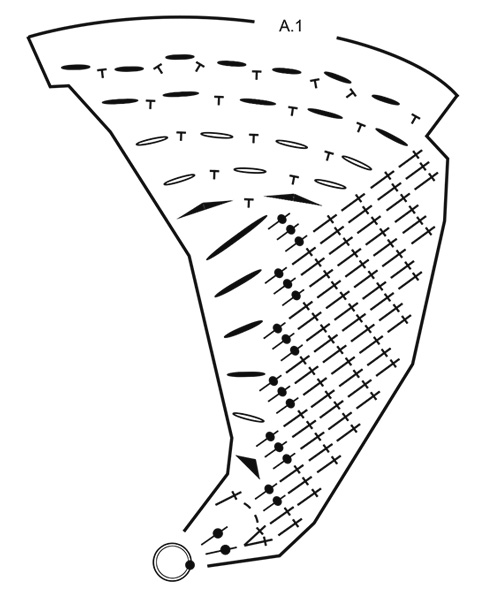
|
|||||||||||||||||||||||||||||||||||||
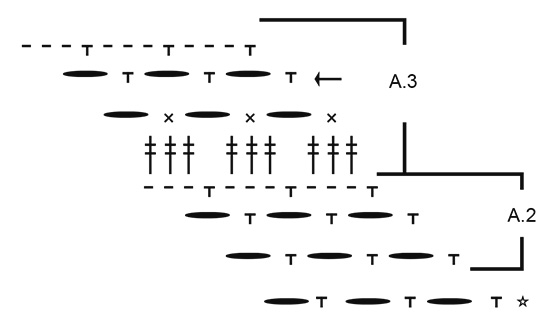
|
|||||||||||||||||||||||||||||||||||||
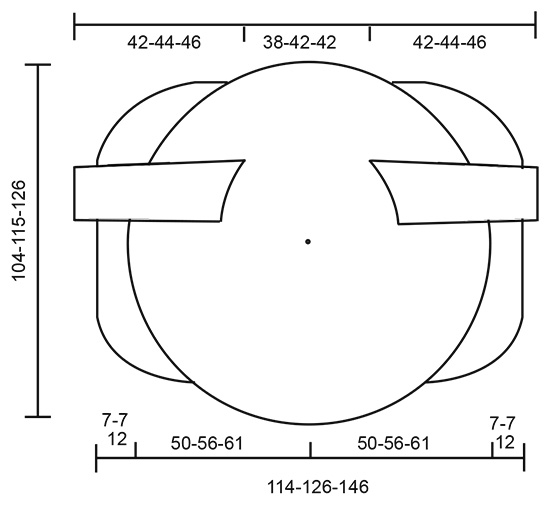
|
|||||||||||||||||||||||||||||||||||||
|
Have you made this or any other of our designs? Tag your pictures in social media with #dropsdesign so we can see them! Do you need help with this pattern?You'll find tutorial videos, a Comments/Questions area and more by visiting the pattern on garnstudio.com. © 1982-2024 DROPS Design A/S. We reserve all rights. This document, including all its sub-sections, has copyrights. Read more about what you can do with our patterns at the bottom of each pattern on our site. |
|||||||||||||||||||||||||||||||||||||











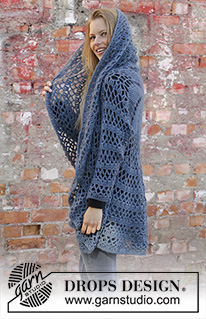
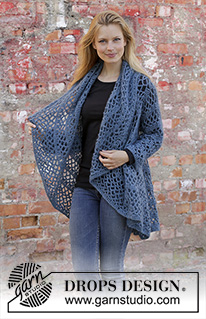

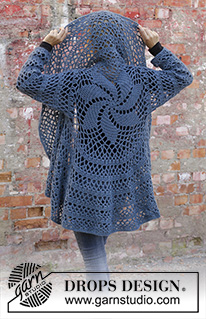


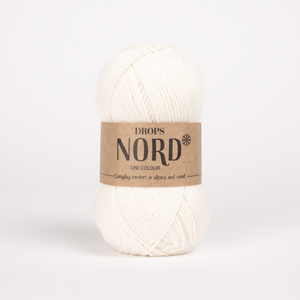
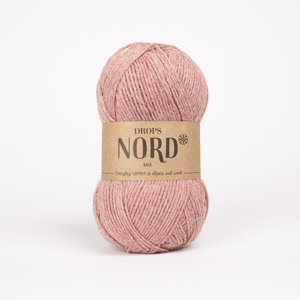








































Comments / Questions (79)
Hej!! I början av mönstret står det att jag ska använda båda garnerna men när ska jag endast använda en tråd? Eller är det dubbelt hela tiden? Tänker att det är olika mängd på garnerna. Mvh Carolina
06.07.2020 - 08:08DROPS Design answered:
Hej Carolina. Du ska använda en tråd av varje garn hela tiden. Anledningen till att det är olika mängder garn är att det är olika antal meter per gram garn. Lycka till!
06.07.2020 - 08:33Is there a complete round by round written pattern instruction? I am really trying to follow the diagram pattern and struggling terribly. I cannot get past round 2. I am not very visually oriented for patterns. I am more of a written word pattern follower. Can you help? Is there a complete written pattern? I would love to make this pattern but cannot get past round 2. HELP please?
03.07.2020 - 03:56DROPS Design answered:
Hi Margie, Sadly there is no written pattern for the garment at this stage. Regards, Drops Team.
03.07.2020 - 07:12I made this jacket for my daughter and it is beautiful! Thanks for posting the pattern!
07.04.2020 - 18:24In der Anleitung sind 2 verschiedene Garne angegeben. Ich kann in der Anleitung nichts darüber lesen. Drops Nord und Drops Kid Silk. Vielen Dank im Vorab
29.03.2020 - 12:57DROPS Design answered:
Liebe Angelika, diese Jacke wird mit 1 Faden DROPS Nord + 1 Faden Kid-Silk (= mit 1 Faden von jeder Garnqualität bzw zweifädig) gehäkelt - siehe Material und Maschenprobe. Viel Spaß beim häkeln!
30.03.2020 - 10:31I am making this pattern in size 3XL. I have just completed the 2nd round in A.2, creating the armholes. The directions state to then work the 3rd round in A.3 without increasing. ?? The directions that follow for all sizes state to work diagram A.3 along with the respective increases depending on garment size. Please help.
06.03.2020 - 19:31DROPS Design answered:
Dear Mrs Victory, after you have worked the 2nd round in A.2, work the 3rd row in A.2 (not A.3 - there is a mistake in the EN pattern and it will be edited asap). Then work a.3 inc as explained for your size. Happy crocheting!
09.03.2020 - 09:35I am nearing the completion of A.1 so the 49 chains before A.2 does not make sense. There are 49 chains in total after the 7th round in A.1 plus 21 chains more in each of the 7 sections. Please explain. Thanks.
04.03.2020 - 02:33DROPS Design answered:
Dear Mrs Victory, when you crochet the armhole round you have: 7 ch-spaces, 35-ch-space (armhole over the 8 skipped ch-spaces), 19 ch-spaces, 35-ch-space (armhole over the 8 skipped ch-spaces) and 7 ch-spaces, Then work A.2: over the first 7-ch-spaces inc 2 ch-sp (= 9 ch-sp) + 10 ch-spaces around the 35-ch-space + 19-ch-spaces inc 7 ch-spaces (=26 ch-sp) + 10 ch-spaces around the 35-ch-space + 7 ch-spaces inc 2 ch-sp (= 9 ch-sp) = 9+10+26+10+9=64 chain spaces in total on first row in A.2. Happy crocheting!
04.03.2020 - 09:04Can you diagram or better explain the increase tip. Thank you.
21.02.2020 - 23:44DROPS Design answered:
Dear Mrs Jones, wen you work the chain-spaces you work ch-spaces with 6 chain-stitches and 1 sc in the ch-space from previous round. To increase 1 ch-space you will crochet in the same ch-space: 1 sc, 6 ch-stitches, 1 sc, 6 ch-stitches and continue as before with 1 sc in next ch-space. Happy crocheting!
24.02.2020 - 08:00I've successfully gotten to round 4 from the start. Here it says chain until you get.to the.mide of the chain space. Is that chains in stitches?
15.02.2020 - 18:34DROPS Design answered:
Dear Mrs Jones, CROCHET INFO-2 applies only when there is a chain space at the beg of the round, then you will have to start the round with 1 sl st in each of the chain stitches of first ch-space until you reach the middle of the ch-space, but this doesn't apply to A.1 (only to A.2 and A.3). Happy crocheting!
17.02.2020 - 08:45Hello, I am stuck at 3rd row of A.2. I understand the instruction is; single crochet, 3 chain stitch then single crochet, 3 ch stitch, etc again all around the circle including the long chain of armhole correct? my question is, how many of the 3 chain stitch do I make in the armhole chain? I tried making 9 - 3 chain stitches but because the armhole chain is loose, it left quite a big of the long chain hanging. Is this correct? I understand the total number of chain should be 64. Help!
26.12.2019 - 17:00DROPS Design answered:
Dear Ani L, make sure there were 64 ch-spaces at the end of row 1 in A.2 , then on row 3, just crochet as before (with 9 ch-spaces in the armholes, ie as if there wouldn't any chains). Happy crocheting!
02.01.2020 - 11:08I live this look! I find it a little challenging to follow and wonder is there a possibility of creating a tutorial from start to finish., either you or allowing someone else to post it.
28.11.2019 - 16:24DROPS Design answered:
Dear Judi M, to help you reading diagram, please read this point in our FAQ. For any individual assistance you are welcome to contact your DROPS store, even per mail. Happy crocheting!
29.11.2019 - 08:47